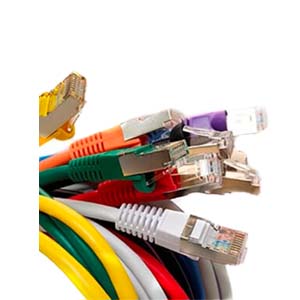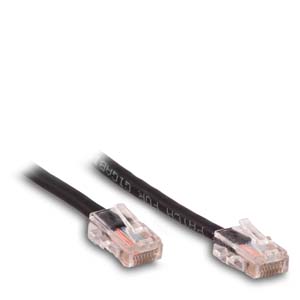Cables Blog
What's What? A Homeowners Guide to Common Cables
In today's technological world, one quickly loses track of all the different types of cables spanning from device to device. Although cables have become more and more standardized over the years, the technological tyro can quickly become overwhelmed by all the different types of USB, DVI, and Ethernet cables. We are here to help you make sense of your cable drawer, sorting out the various types of cables and their respective uses.
by Vikas Dayal • June 19, 2017
In today's technological world, one quickly loses track of all the different types of cables spanning from device to device. Although cables have become more and more standardized over the years, the technological tyro can quickly become overwhelmed by all the different types of USB, DVI, and Ethernet cables. We are here to help you make sense of your cable drawer, sorting out the various types of cables and their respective uses.
Today, we are going to help you familiarize yourself with some of the most important cables you might have around your household. These cables carry out a variety of different functions for your household needs. You use them to charge your phone, upload photos to your computer, or plug your video game system into your television. It's important to understand the uses of these different cables because they open up a lot of different options. You might, for instance, learn how to watch internet movies using a monitor by plugging your laptop into your big screen with an HDMI or DVI cable. Maybe you want to impress your boss or professor by helping them set up a PowerPoint presentation. Whatever the case, understanding the different types of cables and their uses is crucial for making things happen in today's technological world.
USB Cable

If you own a computer, you are probably familiar with the USB cable. USB stands for Universal Serial Bus. If you connect your computer to a printer, phone, camera, camcorder, scanner, or other peripheral device, you are probably using a USB cable. USB cables were designed in the 1990s so that peripheral manufacturers could be sure that their devices would work on any computer. The USB replaced earlier peripheral interfaces, such as the serial port and the parallel port. The USB doesn't simply help your device communicate with your computer, but also often can be used to provide your device with electrical power.
There a three different sizes of USB ports. The standard size fits into your computer port. The mini size is typically used for older cameras and similar equipment. The micro USB, the smallest of the three, is typically used for mobile phones.
USB 3.0 Cable

This version of the USB was released in 2008 and offers a drastic increase in the rate at which information flows between your devices by utilizing a so-called "SuperSpeed USB" transfer rate. These USBs transfer data at around 625 MBps, working almost ten times faster than the USB 2.0, the previous generation of USB technology.
USB C Cable

The USB Type-C is a new and improved version of the USB cable, using a 24-pin reversible plug to transport data and energy between your devices. The reversibility of the plug helps to eliminate the hassle of figuring out which way to insert it, a problem often faced when using previous versions of the USB cable. While standards are still shifting toward USB C, it’s likely you’ve already encountered these out and about.
HDMI Cable

An HDMI (High-Definition Media Interface) cable transmits audio and visual data. You most likely use this to connect your DVD player or video game console to your television.
These were developed in 2003 and have since become the standard way to link your various devices to your TV. Remember the three wires with the red, yellow, and white caps? The HDMI replaced all three of these caps with a single cable. HDMI offers a universal connection cable for both audio and visual using the same technology as a DVI cable with an additional audio component for sound. Nowadays, most computers and computer monitors include both an HDMI and a DVI port, giving customers the option to choose whichever is best suited for their needs.
DVI Cable

DVI stands for Digital Visual Interface. If you have a desktop monitor running Windows, it most likely uses a DVI cable. Some televisions also allow you to transfer visual data from your computer to another screen using this cable. Unlike the HDMI cable, the DVI cable only transmits visual data. If you plug your computer into your monitor using one of these, you will have to either play the audio from your computer or plug in a separate set of speakers.
A DVI-D is digital only. Likewise, a DVI-A transmits only analog. The DVI was introduced when technology turned away from analog in favor of a future that was digital. If you need to transmit both analog and digital signals, you will need a DVI-I cable.
SATA Cable

SATA stands for Serial Advanced Technology Attachment. These replaced the Ide as the standard way to connect a host bus computer to mass storage devices, like optical drives, hard disk drives, solid state drives, etc.
SATA cables are lengthy and contain seven pins. They are thin and flat at the end. The ends attach, on one side, to a port on the motherboard, while the other fits into a storage device.
Some external hard drives use SATA connections by connecting to the SATA connection located on the back of a computer next to the other inputs and outputs. This lets people extend their hard drive directly from the motherboard.
Ethernet Cable

Ethernet cables are primarily used for hooking your computer or other device up to the internet. These carry broadband signals between your modem, router, wireless internet device, and your computer. These cables help you to connect to and tap into your high speed internet service.
These are also sometimes called "Category 5" cables (Cat 5). While Ethernet cables function well for giving you the fast internet speed you need, they fail to function well over a distance. The maximum length for a Cat 5 Ethernet cable before signal loss is 324 feet. One can upgrade to a "Category 6" (Cat 6) Ethernet cable for a bit of an extra boost, extending the range of these cables to 700 feet.
Crossover cables typically connect two computers to each other, while others are manufactured to link a computer to a router.
The two basic types of Ethernet cables are solid and stranded.
A solid Ethernet cable has slightly better performance and protection. These are often used for businesses, and might be run underneath walls or under the floors of a laboratory or library.
The stranded Ethernet cables, by contrast, are the ones you likely have in your own home. These are designed to withstand the strains of physical damage and impact.
FireWire Cable

FireWire cables are mostly used for transferring data between machines. These were developed by Apple in the 1980s and carry power over a copper cable to your devices. These are similar to a USB, and may be used for printers and scanners.
These are useful for transferring data quickly, moving data at over 400 Mbps. They allow for you to have many devices on the same bus and are fairly easy to use. Most importantly, they provide power through the cable – Apple's major innovation in their design.
Fiber Optic Cable

These cables send information at light speed using fiber optic technology. Fiber optics are thin strings of pure glass, through which information in the form of light signals are transferred. These are typically used to send information over long distances, and are sometimes used to provide internet, cable television, and telephone information at lightning-fast speeds.
A glass core forms the center of the fiber optic cable, housed within numerous layers of material for added protection. Fiber optic cables are immune to electronic interference because they transmit light rather than electricity. Such cables are ideal for environments that might have heavy electronic interference.
These cables can transmit signals much further than a coaxial cable, and at higher speeds. They help with video conferencing as well as various scientific experiments. Although fiber optic cables aren't much more expensive than copper cables, they are difficult to install and maintain.
Coaxial Cable

A coaxial cable utilizes an inner conductor surrounded by a tubular insulating layer with a woven copper shield and inner dielectric insulator. These are the cables that bring you your cable television service. Your home will typically have one already installed due to the widespread use of cable TV over the years. Other people use these cables to attach to their personal antenna. If you move into a new apartment, you will probably notice these cables sticking out of your wall in various places.
These are difficult to install, typically requiring a technician from the cable company. The main reason the cable company uses these cables is because the thick insulation prevents signal resistance, making sure you only pick up the signals from your own cable, satellite, or dish. Such coaxial cables are also capable of carrying Ethernet signals, making it ideal for your internet service provider to use. There are two different sizes of cables, called "thinnet" and "thicknet." The thicknet cables have an additional plastic cover for extra protection.
Conclusion
We have now gone through the all-star lineup of cables likely keeping many of your devices connected and working together. The USB cable, we saw, attaches devices to your computer. The FireWire cable offers an older version of this technology. The VDI cable sends video signals while the HDMI sends both high definition video and audio. The SATA cables are for connecting storage devices directly into your computer's motherboard. Meanwhile, the Ethernet cables, Fiber optic cables, and coaxial cables let you transfer information like internet or television signals across your home. The Ethernet offers high speeds at short range, and the fiber optic cables offer high speeds over a greater distance, while the coaxial cables offer long range connectivity with easier installation.











